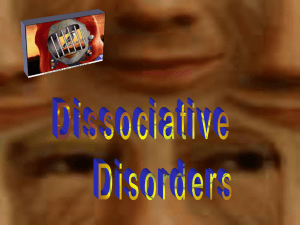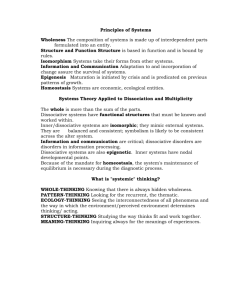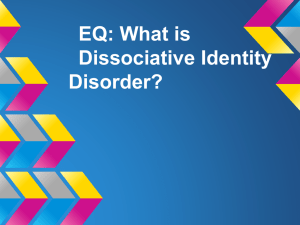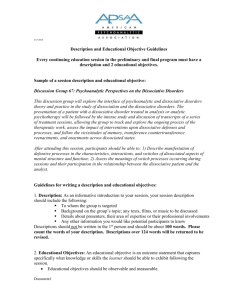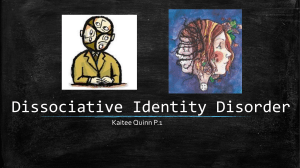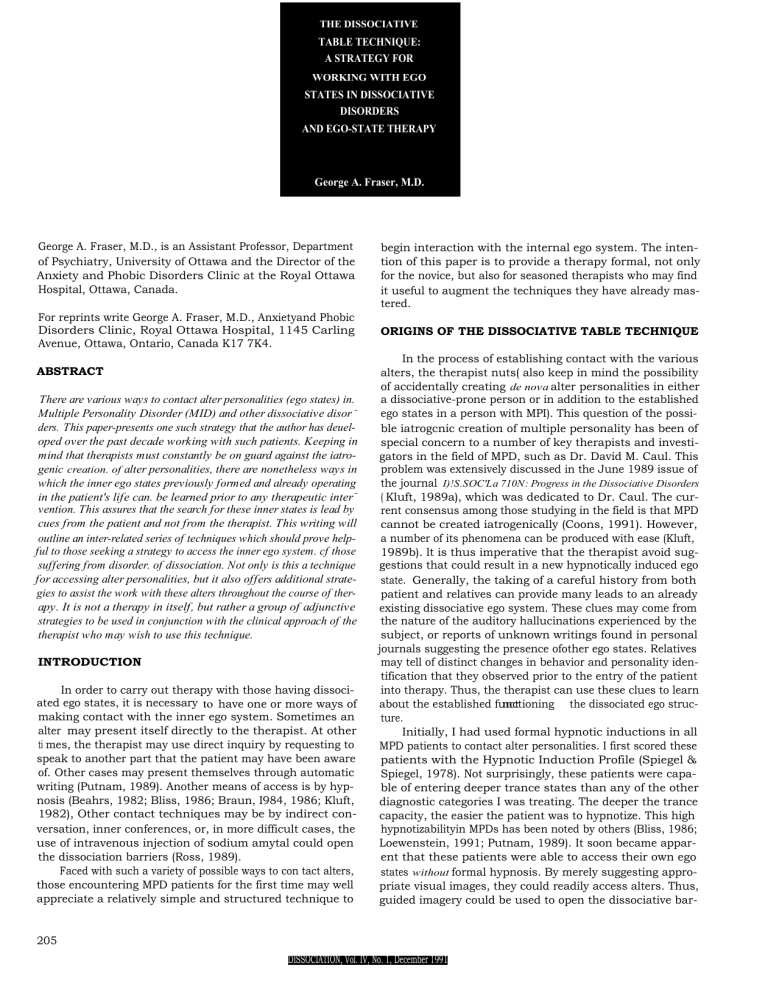
THE DISSOCIATIVE
TABLE TECHNIQUE:
A STRATEGY FOR
WORKING WITH EGO
STATES IN DISSOCIATIVE
DISORDERS
AND EGO-STATE THERAPY
George A. Fraser, M.D.
George A. Fraser, M.D., is an Assistant Professor, Department
of Psychiatry, University of Ottawa and the Director of the
Anxiety and Phobic Disorders Clinic at the Royal Ottawa
Hospital, Ottawa, Canada.
For reprints write George A. Fraser, M.D., Anxietyand Phobic
Disorders Clinic, Royal Ottawa Hospital, 1145 Carling
Avenue, Ottawa, Ontario, Canada K17 7K4.
ABSTRACT
There are various ways to contact alter personalities (ego states) in.
Multiple Personality Disorder (MID) and other dissociative disor ders. This paper-presents one such strategy that the author has deueloped over the past decade working with such patients. Keeping in
mind that therapists must constantly be on guard against the iatrogenic creation. of alter personalities, there are nonetheless ways in
which the inner ego states previously formed and already operating
in the patient's life can. be learned prior to any therapeutic inter vention. This assures that the search for these inner states is lead by
cues from the patient and not from the therapist. This writing will
outline an inter-related series of techniques which should prove helpful to those seeking a strategy to access the inner ego system. cf those
suffering from disorder. of dissociation. Not only is this a technique
for accessing alter personalities, but it also offers additional strategies to assist the work with these alters throughout the course of therapy. It is not a therapy in itself, but rather a group of adjunctive
strategies to be used in conjunction with the clinical approach of the
therapist who may wish to use this technique.
INTRODUCTION
In order to carry out therapy with those having dissociated ego states, it is necessary to have one or more ways of
making contact with the inner ego system. Sometimes an
alter may present itself directly to the therapist. At other
ti mes, the therapist may use direct inquiry by requesting to
speak to another part that the patient may have been aware
of. Other cases may present themselves through automatic
writing (Putnam, 1989). Another means of access is by hypnosis (Beahrs, 1982; Bliss, 1986; Braun, I984, 1986; Kluft,
1982), Other contact techniques may be by indirect conversation, inner conferences, or, in more difficult cases, the
use of intravenous injection of sodium amytal could open
the dissociation barriers (Ross, 1989).
Faced with such a variety of possible ways to con tact alters,
those encountering MPD patients for the first time may well
appreciate a relatively simple and structured technique to
begin interaction with the internal ego system. The intention of this paper is to provide a therapy formal, not only
for the novice, but also for seasoned therapists who may find
it useful to augment the techniques they have already mastered.
ORIGINS OF THE DISSOCIATIVE TABLE TECHNIQUE
In the process of establishing contact with the various
alters, the therapist nuts( also keep in mind the possibility
of accidentally creating de nova alter personalities in either
a dissociative-prone person or in addition to the established
ego states in a person with MPI). This question of the possible iatrogcnic creation of multiple personality has been of
special concern to a number of key therapists and investigators in the field of MPD, such as Dr. David M. Caul. This
problem was extensively discussed in the June 1989 issue of
the journal I)!S.SOC'La 710N: Progress in the Dissociative Disorders
( Kluft, 1989a), which was dedicated to Dr. Caul. The current consensus among those studying in the field is that MPD
cannot be created iatrogenically (Coons, 1991). However,
a number of its phenomena can be produced with ease (Kluft,
1989b). lt is thus imperative that the therapist avoid suggestions that could result in a new hypnotically induced ego
state. Generally, the taking of a careful history from both
patient and relatives can provide many leads to an already
existing dissociative ego system. These clues may come from
the nature of the auditory hallucinations experienced by the
subject, or reports of unknown writings found in personal
journals suggesting the presence ofother ego states. Relatives
may tell of distinct changes in behavior and personality identification that they observed prior to the entry of the patient
into therapy. Thus, the therapist can use these clues to learn
about the established functioning
nct
the dissociated ego structure.
Initially, I had used formal hypnotic inductions in all
MPD patients to contact alter personalities. I first scored these
patients with the Hypnotic Induction Profile (Spiegel &
Spiegel, 1978). Not surprisingly, these patients were capable of entering deeper trance states than any of the other
diagnostic categories I was treating. The deeper the trance
capacity, the easier the patient was to hypnotize. This high
hypnotizabilityin MPDs has been noted by others (Bliss, 1986;
Loewenstein, 1991; Putnam, 1989). It soon became apparent that these patients were able to access their own ego
states without formal hypnosis. By merely suggesting appropriate visual images, they could readily access alters. Thus,
guided imagery could be used to open the dissociative bar-
205
DISSOCIATION, Vol. IV, No. 1, December 1991
riers of their inner system without any formal hypnosis. This
meant therapists did not have to be hvpnothcr apists in order
to be able to gain access to the inner ego make-up of such
highly dissociative-prone people. However, since the patient,
in essence, is using self-hypnosis, the more a therapist knows
about formal hypnosis, the better understood will he the
phenomenology of the dissociation of each particular pal ien t.
In fact, then, one can access alter personalities through the
technique of "guided imagery." [his is more than an academic point, for in some places, such as the province of
Ontario, where I practice, only physicians, dentists, and registered psychologists can employ hypnosis. Fortunately,
there are no such restrictions for guided imagery. This adds
up to a larger pool of available therapists for these patients.
Having had training in hypnosis, transactional analysis,
neurolinguistic programming, and Gestalt therapy prior to
my work with MPD, these disciplines were an influence in
the formation of this treatment strategy which d call The
Dissociative Table Technique. Some of these strategies were discovered serendipitously, and others were invented in response
to pressing clinical circumstances. Over the years, these strategies blended in a way that provides the therapist with a simple and logical format to work with the patient's internal
dissociative system. Within the dissociative table technique
are both new and adapted strategies that are combined in
a special way t.o access the inner dissociative ego states, be it
MPD, other dissociative disorders, or a template for Ego-State
Therapy (Watkins & Watkins, 1981).
It must be cautioned, however, that any use of guided
i magery in dissociative-prone people can have a profound
effect. Their inner make-up allows them to readily respond
to any suggested imagery. As a consequence, there are two
cautions that must be considered in the use oft he Dissociative
Table Technique. Firstly, it should only be used by a qualified therapist or by someone in st.tpet- vision or consultation
with a person who is knowledgeable of dissociative phenomena.
Secondly, the Dissociative Table set-up should not be used to
open the inner ego system unless there is a plan for followup therapy that can deal with the resultant structural changes.
It would be unethical to open up the dissociative barriers
and leave the patient without the resource of a therapist to
deal with the consequences of opening the dissociative doors.
DISSOCIATIVE TABLE TECHNIQUE
The following strategies that make up The Dissociative
Table Technique will be discussed:
1. Instruction in relaxation imagery
2. Dissociative table imagery
3. Spotlight technique
4. Middleman technique
5. Screen technique
6. The search for the Center-Ego State
(Inner Self-Helper, ISH)
7. Memory Protection Technique
8. Transformation Stage Technique
9. Fusion/Integration Techniques
As mentioned above, multiple personalities may develop new
apparent personalities in response to therapeutic intervention techniques. However, these new personalities do not
have past histories (Kluft, 1989b), and can generally leave
as quickly as they appeared once it is made clear to them
that they are neither welcome not needed. It is not surprising that a person who developed new personalities to handle stressors might tend to develop yet another to handle
the new stressor of therapy (Kluft, 1989).
It would take too much spare to discuss how each technique evolved, though each has an interesting history. I will,
however, hi icily mention the origin of some of them.
Once you have made a tentative diagnosis of MPD, other
dissociative disorder, orwisl t to conunence Ego-State Therapy,
the patient is told that it is important to understand the
make-up of their inner ego structure. Since many alters/ego
states fear their extinction, it is important to immediately
assure that no alters can or will be eliminated. Instead, you
will be teaching them a new way to relate to each other; a
way that shows respect for all alters/personalities/ego states
( whichever you prefer to call them).
INSTRUCTION IN RELAXATION IMAGERY
The first step I use in preparation to gain access to the
inner personalities is relaxation imagery. The wording used
in this paper is essentially what I use. Therapists should make
adjustments to suit their style of speaking. "I would now like
you to close your eyes and visualize a scene that is very relaxing and safe. It may be a beach, a country scene, a favorite
room, or any place that you feel is safe. I would like you to
also place yourself in that scene and describe for me, in as
many sensory modalities as possible, what you are experiencing. "
This is a common relaxation imagery which prepares
the patient for the dissociative table imagery. The aim here
is to test the patient ' s ability to use guided imagery. Most
can readily experience a visual image and elaborate it with
other sensory modalities. By asking the patient to describe
the scene, you are establishing a verbal bridge between the
inner visualization and yourself. This also teaches them that
they are able to verbally communicate any imagery they will
be experiencing in the upcoming techniques. By asking that
they see themselves in the scene, you are preparing them to
include the presenting personality in the strategies.
Rarely, they may experience nothing with their initial
i magery testing. Possibly this is because an error has been
made in diagnosis, and the patient simply cannot experience visual imagery. More likely, however, this could be clue
to " resistance. " As a colleague said, sometimes resistance is
a form of protection against delving into their dissociation
before they are ready to cope with the results. This inability to visualize is uncommon in my clinical experience with
patients having high dissociation capacity. If this happens,
I would suggest that you reconsider dissociation as a diagnosis, or take a very close look at possible reasons for resistance. In most cases, the relaxation imagery is easily accom"
plished and the patient is ready to be introduced to the "table
i magery.
206
DISSOCIATION, Vol, IV, No. 4. December 1991
DISSOCIATIVE TABLE TECHNIQUE
THE DISSOCIATIVE TABLE IMAGERY
This is the most interesting and probably the most important of all these interventions. It had its origin in Gestalt
Therapy, though here it has been expanded and adapted
for use with MPD. Some colleagues who have tried this dissociative table imagery have also referred to it as a boardroom
or conference room technique (Ross, 1989). I believe it to he
one of the easiest and most effective ways to he introduced
to the group of alters in Nil'I) patients. My verbalization is
approximately as follows:
" Now I would like you to change that relaxing scene to
that of a pleasant room. In this new room is an oval table.
Around that table are a number of chairs. This is a very safe
room. In this room, no one gels hurt. I don ' t hurt you you don't hurt me (I especially emphasize the latter if there
is a history suggesting violent alters!). One of the chairs is
reserved for you, the rest are for the others that you suspect
are within you. (I let the patient decide how many chairs are
present.) Nod your head when you see yourself in one of
the chairs. (I await for the nod which will be given in most
cases unless resistance arises.) Now I would ask you to invite
the ` others ' " or " those who belong to the voices you have
been experiencing ... ` or ' those your friends have reported
meeting. " I try to use the terminology used by the patient
to refer to suspected ego states. Sometimes the number of
chairs may he the first indication of the number of alters
present: empty chairs can indicate alters not ready to engage
in therapy vet. "Ask them to choose a chair and join you at
the table."
About half the time the patient will, within a minute,
report people taking their place in the chairs. At other times,
there may be some resistance, and the patient may state,
"there are chairs, but. not one has come into the room." At.
that point, I simply say, "look toward the door in the room
and invite them to enter. Reassure them that no one will be
hurt in this safe room. " ( Generally this is shortly followed
by a number of alters entering the room.)
Some patients, perhaps, have been abused at home in
a room with a table and may tell you " rooms with tables are
not safe." Square or rectangular tables can sometimes cause
problems, and an alter may complain, "How come so-andso gets to sit at the head of the table? " The other problem
could be with round tables. Round tables could have "ritual abuse" associations. The use of an oval table generally
bypasses such problems.
For those who cannot handle rooms with tables, one
could suggest they gather in a field, or perhaps on a rock by
a stream, or wherever they feel safe. Most are able to use the
'
`
table, but not all. In any event, I proceed, but take note of
what image they have selected.
"Now that those who feel safe have arrived, I would like
you to describe who is sitting at the table (or whatever is
appropriate to the image they chose)."
What must be pointed out is that this simple table imagery
suggestion can unveil a lot of new information. The patient
can immediately identify many (sometimes all) of the personalities, their approximate ages, sex, and many emotional characteristics of their internal ego system. Be aware that
often not all alters come to the first table setting! Some may
wait weeks and even years before they trust enough to reveal
themselves to the therapist. Some may come but not sit, others may be seen hiding in the shadows. I have learned to
accept their initial limited area of trust. Eventually, they all
come to the table.
The most i mpor tant happening irr this simple maneuver is that for marry patients/clients, this may he the first time
they can actually .see the people within.. Even more intriguing is
that what they visualize by this technique is not what they
(as the presenting personality) expect is the image related
to the voices they hear, or ego states they have been told
about -instead, they see the image that each ego stale has of itself!
So the Dissociative Table Imams, in as little as sixty seconds, can produce a gigantic leap in conceptual awareness
of the alter ego system.
Dialogue Set-Up
Now that the "group " has come to the table, I suggest
that those who have been reluctant, to come, at least listen
in or watch from the background. That will give them a better idea of what is going on in therapy. Now that they can
see each other, it is necessary to set up the lines of inner
communication.
THE SPOTLIGHT TECHNIQUE
This was developed after I read The Mi nds of Billy Milligan
(Keyes, 1982). Billy was a patient ofa departed friend and
respected colleague, Dr. David Gaul, who was previously mentioned. The book relates how the alters of Billy "imaged"
themselves as having a stage spotlight shining on the alter
who was the one in executive control of the body. Thus, I
have adapted this and say to the ego states, "While you are
sitting at. the table, you will notice a spotlight over the head
of the person who has been speaking to me. Whoever this
light shines on is the one who is able to communicate directIv with me. You cart move that spotlight to shine on another person at the table so I can get to meet that person. As
you look around the table, find someone who is willing to
speak to me. Nod your head when someone has agreed.
Okay, as I count to three, gently move the spotlight to that
person. Ready - one, two, three. Okay, whoever now has
the spotlight shining on them can directly speak with me.
Would you like to speak to me with your eyes open or closed?"
This technique promotes co-consciousness, so the other personalities, including the presenting personality, are able to
hear all the conversations held at the table, be it internally
or externally with me.
This step generally allows for the establishment of cornmunication for the first time between therapist and alter. At
ti mes, the use of the spotlight has proven helpful in even
revealing those who may conceptualize themselves as hiding in the shadows. It may be better, however, not to rush
such reluctant alters to participate until they are ready and
come to the table on their own.
Some people feel very uncomfortable with a spotlight.
In some cases this could be because they were exploited
through pornography. If the spotlight is a problem, I sag-
207
DISSOCIATI011,1'MAY, No. 4, December 1991
ERASER
TABLE I
Dissociative Table Technique (Inner Organization Plan)
Name
D,O,B.
File #
Intake Date
Age
Session Date
Presenting
Others
Others
D.E.S. Score
Complete
11.1.P. Score
Complex
N.O.S.
Ego-State
Therapist
UPPER SECTION: The oval refers to the table. The lines refer to the chairs, and the personalities' names are entered here.
Sometimes the seating arrangement is important. The name of the personality who came to therapy originally is put in "Presenting"
line. Inside the oval are two groups of boxes. Check whether a Center-Ego (honer Self Helper) has been contacted and, also,
whether other personalities are co-conscious when that state is in executive control during the therapy. This varies from patient
to patient. "Others" refers to ego states who do not want to come to the table yet, or are in the shadows.
LOWER SECTION (OPTIONAL): D.E.S. Score: Refers to the Dissociative Experience Score (Bernstein & Putnam, 1989). H.LN.
Score: Refers to the Hypnotic Induction Profile Score (Spiegel & Spiegel, 1978), Complete: Check if classical MPD. Complex:
Check if poly-fragmented MPD. N.O.S.: Dissociative Disorder Not Otherwise Specified. Ego-State: Cases which may not have a formal dissociative state diagnosis, but in which Ego-State therapy is being used.
208
DISSOCIATION, Vol. IV, No. 4. December 199]
DISSOCIATIVE TABLE TECHNIQUE
gest that, instead, they could use a microphone and pass it to
each other to exchange executive control as each speaks to
me.
At this stage, I caution the reader that you are entering
into a system that may never have related in this manner
before. Some alters may have only been out it► moments of
aggression, fear, or violence. 11 . may he very threatening for
these personalities to relate to you, so I state, "If you do not
feel safe to be out now, or fear you may harm me, you may
not be ready to come out yet. " ( The word "vet " is a very powerful word in the language of imagery, for it implies that
there will he a time in the future when this will be possible.)
If some are not able, or are reluctant, to speak with me, and
this is conveyed to me by a report from another alter, I can
resort to the middleman technique.
MIDDLEMAN TECHNIQUE
One of- the potential problems with the spotlight technique is that the ego-state with the light or the microphone
may refuse to speak for a host of possible reasons. Besides a
si mple refusal to speak, it might be an ego state that is too
young to speak, electively mute, speaking a different language, or, though much less likely, it could be a non-human
alter.
In such cases. the middleman technique is a possible
solution. I address one of the ego states who has established
contact with me, and ask that it act as a go-between, negotiator, or interpreter between myselfand tkre reluctant alter.
I say, " Since you are not ready to speak to me yet, would your
speak to the person under the spotlight who has been speaking with me, and tell that person a little about yourself and
why you might be having difficulty speaking directly with
me. " Though the middleman conveys the messages to me
in the third person, I continue addressing my questions in
the second person to the reluctant alter. In almost every
case, within a few minutes, this reluctant alter begins speaking directly tome as itappears lo get impatient going through
the middleman. If the alter is mute, I pass a pen and pad
and. ask that the communication be written. If it was a very
young child, I might ask that a picture be drawn. This itself
may lead to some insights, and I might gain further information by asking an alter who knows the child alter to interpret the drawing. If the problem is one of a different language, one can usually find an interpreter sitting around
the inner table. If there is still no communication, 1 might
elicit the help of the inner self helper, which will be discussed.
Once these first two techniques are done, the therapist
is now in a position to use two diagrams which can be used
for quick reference (Table 1.)
The Inner Organization Plan ('Table 1) can be kept in
the patient ' s file or in a separate binder so it can be kept in
an easily accessible area for a quick reference during therapy. It may have to be renewed a few times during therapy
as new alters emerge and others merge.
The Individual Profile (Table 2) is used as a quick reference sheet, and lists the main personality traits of the egostates. It can be kept in the same location as the Inner
Organization Plan.
SCREEN TECHNIQUE
Discovering the secrets of dissociated memories is an
essential, though emotionally painful, process. In the course
of memory retrieval, the patient often relives the fear, the
hurt, and the terror, as if the event were happening all over
again. In an abreaction, the patient may regress in time and
could even confuse the therapist as one of the abusers. These
abreactions at times can become too strenuous and exhausting and may not be appropriate for any place but a protected
inpatient setting.
Because I work in an outpatient setting whi t many other
neighboring offices, I had to devise a more moderate way
of memory recovery. Drawing on my memory' of the hypnotic techniques I learned from Herbert and David Spiegel
at their hypnosis courses, Columbia University, I recalled
they frequently used a screen to project images in some of
their hypnotic strategies (Spiegel & Spiegel, 1978) . This had
potential fora strategy that would allow fora controlled abreaction. I decided to add a movie screen or TV monitor in
the room with the dissociative table. The alters could now project the scene of the abuse memos on the screen vet be safely sitting at the chair at the dissociation table. While this
somewhat (but not always) distances the intensity of the recalled
memory, it generally offers adequate emotional connection
to be effective without having a difficult abreaction to manage. Since everyone can see the screen from the table, that
memory can be seen by all who are willing to watch. They
also can see and experience the emotional reaction of the
person who is showing/sharing that memory. The suggestion that they have a remote control unit allows them to stop,
start, rewind, or fast forward that scene. I state, "you will
notice that to the side of the table is a screen (or a TV A monitor). Each person can share memories, along with the ftelings
that. go with them, on that screen. The person reviewing the
memory, or anyone else, can narrate what is happening so
I can know what you are recalling. If the scene becomes too
difficult, just press the stop button, and we can continue at a
later time. Okay, who is ready to share a memory?" Some
therapists prefer to review memories chronologically; others by working through one personality's memories, then to
the next, and so on; others may prefer to allow the alter to
select their own memory review schedules.
Some personalities may use the screen to view the knowledge of the memory,' but still try to distance the emotional connections (Braun, 1988). To guard against this, check every
so often to ensure that there is the emotional connection
with the memory being reviewed. If not, I say, "as (name of
alter) is showing the memory, I want you all to join hands
and connect with the feelings that go along with this memory."
THE SEARCH FOR THE CENTER-EGO STATE
(INNER SELF HELPER, ISH)
Most know this as the Inner Self Helper (ISH) , as coined
by Dr. Ralph Allison (1974), though earlier therapists,
209
DISSOCIATION, Vol. IV, No. 4, December 1991
including Pierre Janet, were also aware of this special egostate. Articles have been written on this subject, but there is
still little consensus on its universality or even of its need in
therapy (Adams, 1989; Allison & Comstock, 1987, 1989; Kluft,
I989b). Since I have found it useful in many cases, I will
include the technique I devised to allow access to this state.
There can be various alters who consider themselves to he
inner self helpers but do not correspond to Allison ' s descriptions. This can cause confusion at times. Consequently,
Christine Comstock, an MP[) therapist who has also spent
considerable time studying this slate, and I have preferred
to refer to the ISH as the "Center Ego State " (Comstock,
1991). Essentially, this is an ego-state which appears to have
the knowledge of the entire ego structure and the histories
of the alters. This ego-state can sometimes he helpful in providing a better understanding of the system. It is a special
state which seems to have a function of keeping some sense
of background continuity of time for the system. It appears
to be more logical than emotional and often believes itself
not to he a personality (Fraser, 1987). Nonetheless, I believe
this is just a special purpose ego state that can, but need not,
be used in therapy. Descriptions by this state are much in
the style one hears in other patients who have spoken about
out of body experiences and have felt as if they were obser7 ing
themselves from without. My studies of those states make
me suspect a Center-Ego originates as a result of the very
first dissociation of the traumatized child. In any event, until
more is known, this will remain a controversial issue. I will
TABLE 2
Individual Profile
CHART #
Name
Age
Sex
Profile
Name
Profile
Age
Sex
Age
Sex_
Age
Sex.
Profile
Age
Sex
Profile
Name
Name
Name
Profile
Age
Sex
Name
Profile
210
DISSOCIATION, Vol.IV, No.1, December 1991
DISSOCIATIVE TABLE TECHNIQUE
describe how I contact this state. Some therapists have reported that this state has presented spontaneously during therapy. Some treat it as a co-therapist. I view it as a helpful ego
state of a patient/client but keep in mind that, while I may
consider its suggestions, I must be the one in charge of the
therapy.
"There may be an ego state that has memories °fall your
personalities. (1 realize this is a leading question, but used
non-directive questions while developing this technique.)
This would be helpful as a possible guide to better understand the origin of each other. Would you mind if I used a
special technique to locate this state? " If the patient agrees,
I continue... " I would like you and all the other personalities to return to your chairs at the table. Look at the screen,
and I would like you to select a scene or a movie which you
would like to place on that screen. Thu each can select your
own movie if you wish. Now, as you begin to watch, I want
you to become so involved in your picture that you can feel
yourself entering that scene. I will call vor.r back soon; in the
meantime, enjoy your movie."
Then, as I address the body left in my office chair, I continue_.. " please nod your head when they have all left my
office." This, of course, is a double-bind situation. Next, I
say, " since all the personalities have left, I wonder if you
could let me know where you fit into the system?" Sometimes
an alter who had not yet presented itself to the table may
think this was a trick to find him/her. If so, and this state
emerges, I quickly thank this state for agreeing to reveal itself
and invite it to join the others at the table, watching a movie.
More likely, I will, in fact, have the Center-Ego (ISII) who
will state something like, "I ' m the one who watches." Without
asking leading questions, I want to know if this state qualifies as Center-Ego, i.e., has knowledge of memories of all
the alters, though may not consider itself as anything more
than an observer. While I do not believe Center-Egos are
essential for therapy, in many cases I have found them to be
a valuable aid. Sometimes they may be surprised you found
them and even more so that. they can communicate. Questions
ofiatrogenous often arise in connection with this state (Kluft,
1989b). Special precaution was taken to avoid iatrogenesis
as this technique for finding the Center-Ego was being developed in conjunction with the dissociative table strategies.
MEMORY PROTECTION TECHNIQUE
Sometimes a memory oil the screen is very painful and
causes such distress that the patient just cannot go on with
that memory work. If so, I use the following way of creating
a new protective memory to be associated with the recalled traumatic memory, in order to gain mastery. Here, one can combine imagery with audio-visual technology.
I may say, "it seems that the little child in that scene is
very frightened and lonely. Why don ' t you get up from the
table, walk right into the screen, and hug and nurture that
child. Tell her that she is not bad, and soon she will be safe
with you. " One could also say, " perhaps there is something
you may wish to say to that adult who is hurting the child.
Let's go into that scene, and I'll back you up as you let him
know what you think of what he is doing. " This has often
had very positive effects, allowing the client to pass through
a memory scene that was very traumatic. You have superi mposed a protective image into a former traumatic image.
TRANSFORMATION STAGE TECHNIQUE
t suggest that there is a special stage area to the side of
the dissociative table. When they go on that stage, it can
transform their age or their sex when they request this as
part of the process leading to eventual fusion/integration.
I also suggest there is a mirror to the side so they can see the
changes that will come about.. This technique is helpful when
alters feel too small, too young, or of the wrong sex, and
want to he in harmony with the biological reality.
"
You will notice to the side of the table a special stage
area. As you stand in that area, I can help you advance to
the new age (or sex) we have discussed. 1 will count to five
when you are there. While I am counting, you will notice
yourself change to that. age (or sex) . Ready? One, two, three,
four, five. Okay, nowlook in the mirror and notice the change.' "
Sex changes are only done when going from one that. is in
variance with the biological sex, and only when that alter is
ready.
FUSION/INTEGRATION TECHNIQUES
Finally in therapy, there comes the day that personalities are ready to come together. While many call this integration, I still use the term fu.siorr to indicate the actual act
of physically joining, arid integration to refer to the process of
learning to work together, which can begin before and continue after fusion (Kluft, 1988).
The alters often lack basic trust and expect trickery from
the therapist, leading to their elimination. Thus, I do two
types of fusion prior to the final fusion. One is called partial
fusion and the other is temporal), fusion. In partial fusion, I will
just fuse or unite two, or a few personalities, so the others
can observe that it is safe, and nobody gets lost. or eliminated. In temporary fusion, I use a similar technique as we near
the ti me for fusion of all personalities. I will assure them that
they do not have to stay fused forever if they do not like it,
but they should at least give it. a chance for an hour or a few
days, and then come apart and decide for themselves the
advantages of fusion (and eventually a harmonious integration).
FUSION TECHNIQUE (whether temporary, partial, or final)
"To fuse, I want you to do the following. While at the
table (or at the side of the table, or whatever imagery place
they now have), I want you to join hands in a circle (this has
not caused problems in ritual abuse survivors). As I count
to five, you will walk together into each other, joining as one.
Ready?" After I slowly count, I say, "Now that you are joined
together as one, open your eyes and experience what it is
like being together. Each of you is aware of his or her own
existence, but notice you share your thoughts and feelings.
Notice, too, that there are no voices because you can now
all think together." Sometimes I will do a roll call - if not
211
DISSOCIATION, Vol. IV. No. 4. December 1 991
too many ego-states are involved - to assur e them that they
all exist in this new unit of fusion.
UNFUSION TECHNIQUE
Of course, to have a partial or temporary fusion, you
technique before permanent fusion is attempted. I have made this a simple variation of the fusion technique.
must have an unfusion or drfusion
Bernstein, E.M., & Putnam, F.W. (1986). Development, reliability, and validity of a dissociation scale. Journal of Nervous and Mental
Disease, 174, 727-735.
Bliss, E.L. (1986). Multiple personality, allied disorders, and hypnosis.
New York: Oxford.
Braun, B.G. (1984). Uses of hypnosis
Psychiatric Annals. 14. (1), 34-40.
with multiple personality.
Braun, R.G. (1986). Treatment of multiple personality disorder.
Washington, DC: American Psychiatric Press, Inc.
Technique
"
Now you are ready to return to your individual states.
Close your eyes. As I count backwards from tivc to one, merely step hack into your original circle and let go of hands.
Ready?"
Permanent or final fusion is done usually after a number of trials of the above fusions, and when the personalities have shared their memories and have overcome their
need of separateness. Some patients comment on the physiological hyperawareness, at the novelty of fusion, such as
the brightness of colors, and at the solidity of objects in the
environment. however, for many, by the time of final fusion,
they have experienced so many exciting things during the
course of therapy that. this is more of a special day than a
novel experience.
SUMMARY
Braun, B.G. (1988). The BASK (behavior, affect, sensation, knowledge) model of dissociation. DISSO(1A77ON, I (1), 4-23.
Comstock, C. (1987). Internal Self-helpers or Center. In Ross, C.A.
(Ed,), integration (special edition). Winnipeg: CCISSMPI)_
Comstock, C. (1991). The inne self helper and concepts of inner
guidance: Historical antecedents, its role within dissociation, and
clinical utilization. DISSOCIATION, IV, 165-177.
Coons, P.M. (1991). Iatrogenesi.s and malingering of multiple personality disorder in the forensic evaluations of homicide dependents. Psychiatric Clinics of North America, 14, (3), 752-768.
Fraser, G.A. (1985). Hypnotic strategies for multiple personality
disorder. In Braun, B.G. (Ed.), Proceedings of the second interrr.ationalconferenceon muttipleprsonalily/drs.sociativestales. Chicago, IL: Rush.
I have adapted techniques from hypnosis and other disciplines to a guided imagery strategy for the therapy of MPD
and other disorders of dissociation, including Ego-State
Therapy. Since the MPD patient lives in a dissociative state,
he or she does not need formal trance induction and can
utilize guided imagery quite readily without. requiring the
use of hypnotherapy. Techniques are based on a dissociative table imagery. The imagery of the alters sitting around
a table in a safe room is the more or less stable image in
which the other strategies are adapted. This allows a controlled single setting for the management of the dissociative
aspects of the multiple personality patient from day one to
the day of final fusion. These basic techniques can easily be
adapted to a variety of therapeutic styles. They are meant
only to he adjuncts to the real work of the therapist. --- the
psychotherapy. It is hoped that these techniques will be helpful in facilitating the management of those who have been
divided by abuse. ■
Fraser,G.A. (1987).TheCentral-lSII:The ultimate inner self-helper.
In Braun, B.G. (Ed.), Proceedings of the second international conference
on multiple personality/dissocialioe stales. Chicago, IL: Rush.
REFERENCES
Kluft, R.P. (1989b). latrogenic creation of new alter personalities.
DISSOCIATION, Il (2), 83-91.
Adams, M.A. (1989) . Internal self-helpers of persons with multiple
personality disorder. DISSOCIATION, II (3), 138-143.
Allison, R.B. (1974). A new treatment approach for multiple personalities. American ,journal of Clinical Hypnosis, 17, 15-32.
Beahrs, J.O. (1982).
Fraser, G.A. (1988). Guided imagery: The dissociative table technique iii the treatment of multiple personality and ego-state therapy. In Braun, B.G. (Ed.), Proceedings of the fifth international conference on multiple personality/dissociative slates. Chicago, IL: Rush.
Keyes, D. (1982).
Toronto: Ban tarn.
Kluft, R.P. (1982). Varieties of hypnotic interventions in the treatment of multiple personality. American Journal of Clinical Hypnosis,
24 (4), 230-240.
Kluft, R.P. (1988). The post-unification treatment of multiple personality disorder: First Findings. American Journal of Psychotherapy,
42 (2), 212-228.
Kluft, R.P. (1989a). (Ed.). The David Caul memorial symposium
papers: Iatrogenesis and MPD. DISSOCIATION, II (2), 59-104.
Loewenstein, R.J. (1991). An office mental status examination for
complex chronic dissociative symptoms and multiple personality
disorder. Psychiatric Clinics of North America, 14 (3), 567-604.
Putnam,
Unity and multiplicity: Multi-level consciousness
of self in hypnosis, psychiatric disorder, and mental health. New York:
The minds of Billy Milligan.
disorder.
F.W. (1989). Diagnosis and treatment of multiple personality
New York: Guilford.
Brunner/Mazel.
212
DISSOCIATION, Vol, IV, No. 4. December 1991
DISSOCIATIVE TABLE TECHNIQUE
Ross, U.A. (1988) . Multiple personality disorder: Diagnosis, clinical features, and treatment. New York, Toronto: Wiley.
Spiegel, U., & Spiegel, H. (1978) . Trance and treatment: Clinical uses
of hypnosis. New Yu' k: Basic Books.
Watkins, H.H., &Watkius,1.G. (1981). Ego-State Therapy. hs Corsini,
R j. (Ed,) , Handbook of innovative psychotherapies. New York: Wiley.
213
DISSOCIATION, W. IV, Nu. 1, December 1911
